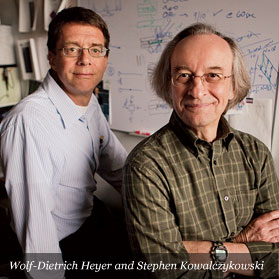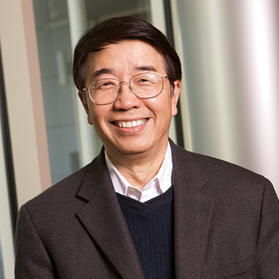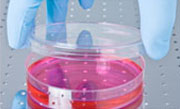Solving a genetic puzzle
 "For any type of drug targeting, one will need the protein to develop the approach. We’ve only really scratched the surface."
"For any type of drug targeting, one will need the protein to develop the approach. We’ve only really scratched the surface."
The BRCA2 protein, produced by the BRCA2 gene, which was discovered in 1994, plays a crucial role in DNA repair. It helps fix problems that can occur during cell division and, if allowed to accumulate, can lead to cancer. Scientists don’t have a detailed understanding of the protein’s function, largely because they haven’t had a complete version of the human BRCA2 protein to work with, despite a decade and a half of research in labs around the world to purify it.
"The lack of a full-length protein was a real impediment. It really held back the field," says Wolf-Dietrich Heyer, co-leader of UC Davis Cancer Center’s molecular oncology program.
The BRCA2 protein is difficult to isolate because of its size and instability – with 3,418 amino acids, it is four or five times the size of the average protein. Researchers have had to make do with studying snippets of it, or investigating similar proteins found in worms, flies or fungi.
The BRCA2 protein is difficult to isolate because of its size and instability – with 3,418 amino acids, it is four or five times the size of the average protein.
But now, two groups of UC Davis researchers, working independently but collaboratively, have successfully isolated the human BRCA2 protein, and they’ve used it to study how the protein helps mend muddled DNA. Funding for the research came from the National Institutes of Health, the U.S. Department of Defense Breast Cancer Research Program, the Susan G. Komen Breast Cancer Foundation, and UC Davis Cancer Center.
Their achievement will enable scientists to study BRCA2 function in much more detail, and to investigate how the hundreds of known mutations in the gene affect the protein’s vital repair role. It may also help researchers develop new tools for diagnosing breast cancer and identifying promising strategies for fighting the disease.
Having the purified protein also will be a boon for researchers looking for new ways of battling breast cancer. Therapies could be developed that bolster the BRCA2/RAD51 repair process, to keep cells healthy, or they could be used to disrupt it in cancer cells, leaving them vulnerable to other treatments.
"This is very exciting and opens doors to understand the detailed action of this elusive, yet dreadful, tumor suppressor," says Hsing-Jien Kung, basic science director at UC Davis Cancer Center and distinguished professor of biochemistry and molecular medicine. "It illustrates how basic biochemistry in the lab can have a significant impact clinically."
There was intense and widespread interest in purification of the protein, says Heyer, whose research group – including postdoctoral researcher Jie Liu, staff research associate Tammy Doty, and Bryan Gibson, now a doctoral student at Cornell University – produced the BRCA2 protein from genetically engineered yeast, adding protein tags to help stabilize it and make it more soluble. The work, which Heyer says involved "an enormous amount of expertise and dedication," was reported in the journal Nature Structural and Molecular Biology. In a lab just down the hall, Heyer’s colleague Stephen Kowalczykowski, a distinguished professor of microbiology who is also with UC Davis Cancer Center, led a group that isolated the BRCA2 protein from cultured human kidney cells, also using protein tags to help the process. Kowalczykowski and postdoctoral researchers Ryan Jensen and Aura Carreira reported their results in the journal Nature.
 "This is very exciting and opens doors to understand the detailed action of this elusive, yet dreadful, tumor suppressor. It illustrates how basic biochemistry in the lab can have a significant impact clinically."
"This is very exciting and opens doors to understand the detailed action of this elusive, yet dreadful, tumor suppressor. It illustrates how basic biochemistry in the lab can have a significant impact clinically."
Having obtained the complete protein, the Davis researchers then turned their attention to investigating its function and how it interacts with other proteins to perform vital repair work. They determined that it works with the RAD51 protein to fix breaks in double-stranded DNA in a process called homologous recombination, which is practically universal, occurring in everything from yeast to plants to primates. The RAD51 protein winds around a single strand of DNA and uses the matching DNA section from the paired chromosome as a template to perform repairs. BRCA2 mediates this process, the researchers found, by helping RAD51 bind to damaged DNA and stimulating its activity. Heyer and his colleagues also discovered that another protein, DSS1, is directly required for this repair process, which is the best means a cell has of maintaining the quality of its DNA.
Now, with the BRCA2 protein purified, researchers will be able to investigate how mutations in the BRCA2 gene can hobble homologous recombination, forcing cells to resort to the more error-prone repair process – predisposing women carrying the mutations to breast and other cancers.
Genetic tests can be used to detect BRCA2 mutations, but the results can be difficult to interpret. With a clearer picture of the protein’s functioning, Heyer says, scientists should be able to better understand the effect and significance of a particular mutation. Kowalczykowski adds that with the complete BRCA2 protein available, "it should be possible to make good antibodies that could be used in inexpensive screening tests."
Having the purified protein also will be a boon for researchers looking for new ways of battling breast cancer. "Knowing the molecular basis of BRCA2 malfunction can help researchers develop therapies for malfunction," Kowalczykowski says. Therapies could be developed that bolster the BRCA2/RAD51 repair process, to keep cells healthy, or they could be used to disrupt it in cancer cells, leaving them vulnerable to other treatments.
Having obtained the complete protein, the Davis researchers then turned their attention to investigating its function and how it interacts with other proteins to perform vital repair work.
"For any type of drug targeting, one will need the protein to develop the approach," Heyer adds. For now, though, he and Kowalczykowski are focused on understanding BRCA2 functioning.
"We’ve only really scratched the surface," Heyer says.







